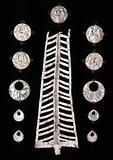Horse fittings, silver
Turkey; 13th century
Diam of lion medallions: 10 cm
There was a great deal of prestige in the equipment used by a mounted warrior or great man and his horse, which is why much care was taken in most cultures in making weapons, armor, and riding tack.
These ornaments were sewn onto the horse’s harness or caparison, since they were not sturdy enough to serve as links between the various leather straps. The long piece probably sat over the horse’s rump.
Confronted animals like these lions in medallions are found on contemporary mirrors and textiles. The silver coins struck by Kay Khusraw II, sultan of the Seljuks of Rum (1237-1246), feature a single related lion passant and a sun symbol.
Inv. no. 3/1976
Published in:
Kjeld von Folsach: Islamic art. The David Collection, Copenhagen 1990, cat.no. 332;
David Alexander (ed.): Furusiyya, Catalog for canceled exhibition, Riyadh 1996, vol. 2, cat.no. 130, p. 163;
Kjeld von Folsach, Torben Lundbæk and Peder Mortensen (eds.): Sultan, Shah and Great Mughal: the history and culture of the Islamic world, The National Museum, Copenhagen 1996, cat.no. 153;
Kjeld von Folsach: Art from the World of Islam in The David Collection, Copenhagen 2001, cat.no. 562;
Eric Delpont (ed.): Chevaux et cavaliers arabes dans les arts d'Orient et d'Occident, Institut du monde arabe, Paris 2002, cat.no. 49, p. 113;
Almut v. Gladiss (ed.): Die Dschazira: Kulturlandschaft zwischen Euphrat und Tigris, Museum für Islamische Kunst, Berlin 2006, cat.no. 27, p. 72;
Linda Komaroff: Gifts of the Sultan: the arts of giving at the Islamic courts, Los Angeles County Museum of Art, Los Angeles 2011, cat.no. 134 and fig. 91;


